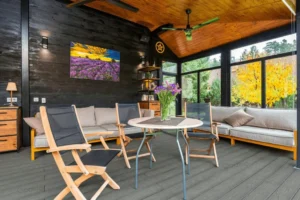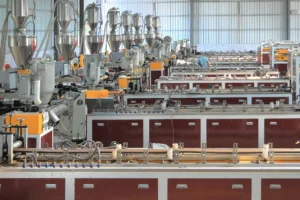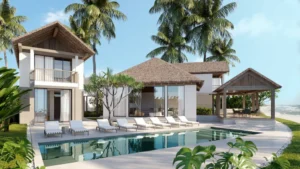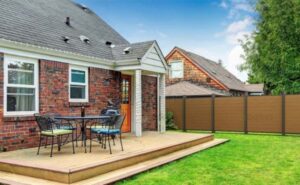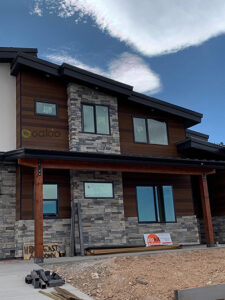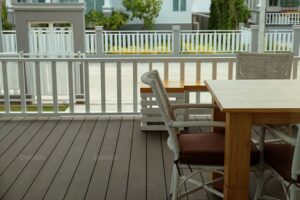What Is Photochromic Wood-Plastic Composites?
In the world of modern landscape design, materials that blend functionality with aesthetics are in high demand. One such material that has been garnering attention is photochromic wood-plastic composites. These innovative materials not only enhance the visual appeal of outdoor spaces but also bring numerous advantages in terms of durability and performance. In this blog, we’ll explore how photochromic wood-plastic composites are revolutionizing the way we approach landscape design, their manufacturing process, and the key benefits they offer for both residential and commercial applications.
The Versatility of Polymeric Materials in Modern Design
Polymeric materials have long been known for their versatility, offering a broad range of functionalities depending on their molecular structure. When combined with inorganic or organic fillers, they can be transformed into functional polymer composites that meet the diverse needs of industries like architecture, construction, and design. These materials are valued for their ability to provide improved mechanical, optical, dielectric, thermal, and safety properties, all while being cost-effective.
However, as landscape design becomes increasingly sophisticated, designers are looking for new materials that offer more than just functional durability. Aesthetic appeal, sustainability, and performance in harsh weather conditions have all become critical factors in choosing the right material for outdoor applications.

The Problem with Traditional Wood-Plastic Composites in Landscape Design
Traditional wood-plastic composites (WPCs) have long been favored in outdoor environments for their resistance to moisture, insects, and decay. However, many of these materials still suffer from a couple of significant drawbacks, especially when it comes to their use in landscape design:
– Limited color variation: WPCs traditionally offer limited color choices, leading to a more static and unchanging appearance. This can result in aesthetic fatigue, especially when the landscape design requires vibrancy and visual interest.
– Fatigue resistance: Another common issue with traditional WPCs is their poor fatigue resistance, meaning they might not perform as well under constant stress or weathering conditions, leading to a reduced lifespan of outdoor installations.
These challenges led designers and researchers to explore a new avenue: photochromic wood-plastic composites, which offer a more dynamic and adaptive approach to outdoor material use.
The Innovation: Photochromic Wood-Plastic Composites
Photochromic materials are those that change color when exposed to different lighting conditions, typically ultraviolet (UV) light. Imagine outdoor furniture, decking, or wall panels that subtly shift their color with the changing seasons or even throughout the day as the sun moves across the sky. This dynamic color change adds an exciting visual element to landscape designs and helps keep outdoor spaces visually engaging over time.
To achieve this, researchers have combined traditional high-density polyethylene (HDPE)-based WPCs with photochromic powders using an advanced hot-pressing technique. This method allows the integration of these powders into the composite material, making it capable of changing color based on light exposure. But there’s more to it—this innovation doesn’t just improve the aesthetics of outdoor spaces; it also boosts the material’s durability.
Key Benefits of Photochromic Wood-Plastic Composites
1. Enhanced Color Change & Aesthetic Appeal
One of the standout features of photochromic wood-plastic composites is their ability to change color when exposed to light. This feature is especially valuable in landscape design where designers are always looking for ways to infuse life and vibrancy into outdoor spaces. The dynamic color shift provides a fresh visual experience, and the materials can be designed to adapt to different lighting environments, ensuring that the design remains engaging throughout the day and across seasons.
2. Improved Fatigue Resistance
Traditional wood-plastic composites often struggle with fatigue resistance—they degrade over time under constant stress or harsh weather conditions. However, photochromic WPCs have been shown to significantly increase fatigue resistance due to the integration of photochromic powder. These materials can withstand exposure to sunlight, rain, and temperature fluctuations without losing their performance. Moreover, the addition of dimethyl silicone oil has been found to help stabilize the color change process without negatively affecting fatigue resistance.
3. Durability in Harsh Outdoor Conditions
Outdoor environments subject materials to harsh conditions, including UV rays, moisture, and temperature extremes. Photochromic wood-plastic composites are designed to perform well under these conditions. The addition of silicone oil to the composite material has been shown to improve color stability, ensuring that the material maintains its visual integrity over time. This makes them a great option for outdoor furniture, landscape features, and other elements exposed to the elements.
4. Sustainability and Eco-Friendliness
As the world continues to prioritize sustainable building materials, photochromic wood-plastic composites offer a significant advantage. By using recycled plastic and natural fibers (like wood fibers or rice straw), these materials are more eco-friendly than many alternatives. They also reduce the need for frequent replacement and maintenance, contributing to the overall sustainability of the landscape design.
The Science Behind the Innovation
In a series of tests, the photochromic wood-plastic composite materials were subjected to various conditions to evaluate their performance. Here’s a quick summary of the key findings:
– Silicone Oil’s Impact: The dimethyl silicone oil added to the composite material significantly enhances color change and stability but has a slight negative impact on the mechanical properties such as bending strength.
– Fatigue Resistance: The photochromic powder was found to be the primary factor influencing the composite’s fatigue resistance. Even after artificial aging tests, the fatigue performance of the composites remained relatively stable, confirming the material’s long-term durability.
– Color Change Trends: Both polypropylene/photochromic composites and polypropylene-based photochromic composites exhibited similar color change trends, showing that this innovation can be applied across different types of composite materials.
The Future of Landscape Design with Photochromic WPCs
As the demand for innovative, aesthetic, and durable materials continues to rise in the field of landscape architecture, photochromic wood-plastic composites are poised to become a leading choice. Their ability to shift colors and withstand the harsh conditions of outdoor environments makes them ideal for urban parks, residential gardens, public spaces, and commercial landscaping.
With the added benefits of improved fatigue resistance, sustainability, and enhanced durability, these materials offer a new way to create dynamic, long-lasting outdoor designs that are both visually stunning and functionally superior.
By incorporating photochromic wood-plastic composites into landscape design, architects and designers can create outdoor spaces that change and evolve with their environment, offering a fresh and exciting experience for visitors and homeowners alike.
Trending Reading
What Are the Differences Between the WPC Board and PVC Board?
[2024 Update] How Long Does WPC Decking Last?
